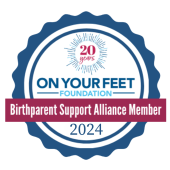The language used in adoption carries weight. It shapes conversations, defines roles, and helps both adoptive and birth families feel more confident and informed throughout the process. If you’re just beginning to explore adoption, you’ll likely come across unfamiliar words. Having a clear understanding of essential adoption terms can make a meaningful difference in how prepared and supported you feel.
Language influences how we think and feel, especially in adoption. Using respectful, informed words helps create clarity, connection, and understanding for everyone involved.
Understanding adoption terminology helps families:
Whether it’s understanding the experience of a birth parent, talking about adoption with a child, or talking through the legal side of things with your adoption agency, being familiar with the language makes conversations smoother and less overwhelming.
Legal words can feel especially intimidating if you’re new to adoption. But once broken down, they’re often simpler than they seem. Here are some of the most common adoption terms you’ll encounter on the legal side.
2.Termination of Parental Rights (TPR) – This is a legal step in which a court permanently ends the legal rights of a birth parent, allowing the child to be adopted. TPR can be voluntary or involuntary, depending on the situation.
3.Finalization – Finalization is the last legal step in adoption, where a judge officially declares the adoptive family the child’s legal parents. A finalization hearing typically happens several months after the placement.
Understanding these adoption terms upfront helps avoid confusion and prepares you for the practical steps that every adoption must go through.
Adoption isn’t only a legal process, it’s deeply emotional. These adoption terminology examples reflect the people, relationships, and feelings that shape every adoption experience.
These terms come up often in conversations with agencies, counselors, and loved ones. Knowing the correct adoption terminology makes those conversations easier to navigate, and helps avoid misunderstandings or unintentionally hurtful phrases.
As you continue learning adoption terms, it’s helpful to understand the different types of placement. Placement refers to where and how a child is placed with a family, and these terms often shape the structure of relationships, expectations, and legal timelines.
1.Domestic Infant Adoption – This refers to the adoption of a newborn or very young infant within the United States. Most often, the birth parent(s) voluntarily place their child with an adoptive family, and the adoption process is handled through a private agency or attorney.
2.Foster Care Adoption – In this type of placement, a child is adopted from the foster care system after the birth parent’s rights have been terminated. These children may be older, part of a sibling group, or have experienced trauma which led them to be in the care of the state. Foster care adoption is often subsidized by the state and involves a different legal process than private domestic adoption.
3.International Adoption – This refers to adopting a child from another country. International adoptions require navigating both U.S. immigration law and the child’s country of origin’s legal process. Families pursuing this path need to work with a Hague-accredited adoption agency.
4.Kinship Adoption – This happens when a relative, such as a grandparent, aunt, or older sibling, adopts the child. Kinship adoption may be formal (through legal channels) or informal depending on the needs and circumstances of the child. These arrangements may arise out of family necessity or crisis and are legally recognized once finalized.
Each of these placement types involves a set of legal, emotional, and logistical steps. Learning these types of adoption terminology helps clarify expectations and options early on.
Adoption involves a lot of paperwork, and understanding what these forms and processes mean can reduce stress. Let’s break down some more key adoption terms related to documentation and administration.
1.Adoption Petition – This is the legal document filed in court to begin the formal adoption process. It includes information about the adoptive parents, the child, and the circumstances of the adoption.
2.Post-Placement Supervision – After a child is placed and before the adoption is finalized, a social worker visits the home periodically to ensure the placement is going well. These visits and reports are part of the required process in many states.
These terms may sound like paperwork on the surface, but each one plays a role in a much bigger picture. Understanding this part of the adoption glossary makes the experience feel more manageable, and less intimidating.
Before placement happens, there’s a period of preparation and decision-making known as the “matching phase.” This is where adoption professionals work to connect birth parents with prospective adoptive families based on shared goals, needs, and openness. Understanding the adoption terminology during this time can help reduce uncertainty and promote better communication.
1.Profile Book – A collection of photos, letters, and personal details created by adoptive families for birth parents to review during the matching process. It offers a glimpse into who they are and what kind of life they hope to offer a child.
2.Matching Meeting – A meeting (sometimes virtual) where a birth parent and adoptive family meet to see if they feel comfortable moving forward with a potential match. These meetings are typically facilitated by an adoption counselor or agency staff member.
3.Expectant Parent Counseling – Support offered to pregnant individuals considering adoption. This counseling helps them process emotions, understand their rights, and decide whether adoption is the right choice for them. It’s a vital part of ethical and compassionate adoption.
4.Hospital Plan – A written plan made in advance of the birth that outlines how the hospital experience will go, who will be present during labor, who will hold the baby first, and how goodbyes will be handled if adoption proceeds. It’s created with sensitivity for both the birth parent and adoptive family.
These terms carry significant emotional meaning, and understanding them helps everyone involved feel more prepared, respected, and included.
As with any topic that involves people and emotion, adoption language continues to evolve. What was once considered standard may now be seen as outdated or even hurtful. Staying updated on respectful adoption terminology shows thoughtfulness and care for others’ experiences.
Here are a few more examples of outdated phrases and preferred alternatives:
These shifts help reduce shame and highlight the dignity of all parties involved. Language matters, and the words we choose shape how adoption is understood by children, adults, and the larger community.
Adoption involves more than forms, agencies, or courtrooms – it’s built on communication, identity, and relationships. The language we use plays a critical role in how secure everyone feels throughout the process. Taking time to learn the most common adoption terms, as well as more advanced adoption terminology, lays a strong foundation for clear communication and healthy emotional development.
Being informed is an act of care. And when families use the right language, they don’t just sound more confident, they are more confident.






